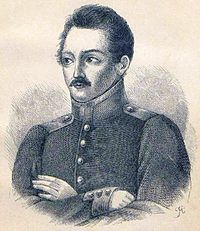갈색 빵
Brown bread | |
| 유형 | 빵 |
|---|---|
| 주요 성분 | 통곡물 밀가루(보통 호밀 또는 밀) 또는 당밀 또는 커피 |
| 260kcal(1089kJ) | |
갈색 빵은 상당한 양의 통곡물 밀가루, 보통 밀, 그리고 때로는 당밀이나 커피와 같은 어두운 색상의 재료로 만들어진 빵이다.캐나다, 아일랜드, 남아프리카에서는 통밀빵이고, 연해주와 뉴잉글랜드에서는 당밀빵이다.미국의 일부 지역에서는 흰빵을 보완하기 위해 갈색빵을 밀빵이라고 부른다.
구운 배균 대신 생밀 배아를 함유한 통밀가루는 글루타티온이 더 높기 때문에 빵 [1]부피가 더 낮습니다.
역사
아일랜드에서는 1848년 이전에 기근 기간 동안 갈색 빵이 [2]가난한 사람들에게 나누어졌습니다.영국에서 갈색 빵은 갈색 [3]식사로 만들어졌다.1845년 전후로 갈색밀은 그다지 바람직하지 않은 곡물로 여겨졌고 그에 따라 가격이 책정되었다.하지만 1865년, 최근에 발견된 겨의 건강상의 이점 때문에, 갈색 밀의 런던 가격은 종종 고운 [4]밀가루보다 더 많이 올랐다.
제분
역사적으로 갈색 밀은 거친 겉겨의 약 90%와 순수 배추 또는 고운 밀가루의 74%를 [5]곡물 전체에서 제거한 후에도 남아 있었다.약간 다른 추출 수치를 사용하여 전체 곡물의 20%를 차지하는 갈색 분말 자체는 약 15%의 미세한 [6]겨와 85%의 흰 밀가루로 구성되었습니다.1848년에는 곡물 제분업자들이 밀기울과 [7]배추만을 알고 있다고 주장했지만 1912년에는 갈색 밀이 배아를 [3]포함한다는 것이 더 널리 알려졌다.
색상
통곡식 빵의 갈색은 프랑스의 [5][8]히폴리트 메주-무리에스가 발견한 시리얼린에 의해 발생합니다.무리에스에 의해 디아스타제와 [8]유사한 활성 주성분 또는 발효로 간주된 시리얼린은 분쇄기가 겨의 일부로 간주한 직사각형 세포의 시리얼 층에서 나왔습니다. 나중에 그것은 대체적으로 알류론 [9]층으로 불렸습니다.무리에스에 기인하는 성명에서, 시리얼린이 중화되면, 겨를 포함한 [5]밀가루로부터 흰 빵을 제조할 수 있다.
품종
아일랜드어
아일랜드산 휘튼 빵은 통밀가루로 만든 아일랜드산 소다 빵의 한 형태이다.
보로딘스키

보로딘스키 빵은 러시아에서 유래한 약간 달콤한 사워도 호밀빵으로 보통 캐러웨이와 고수 씨앗으로 맛을 내고 당밀로 단맛을 낸다.이 빵은 호밀가루에서 나오는 이미 꽤 어두운 색을 더한다.그것은 보로디노 전투의 이름을 따서 지어졌으며, 전설에 따르면, 그것은 그 전투에서 죽은 러시아 장군 중 한 명의 미망인에 의해 발명되었다고 하지만, 실제로는 훨씬 늦은 19세기 말에 만들어졌을 것이다.
보스턴
뉴잉글랜드 또는 보스턴 갈색 빵은 뉴잉글랜드에서 인기 있는 어둡고 약간 달콤한 찐 빵의 한 종류이다.촉촉한 빵은 색이 어둡고 전통적으로 구운 콩과 프랭크와 [10]함께 제공됩니다.
보스턴 갈색 빵의 색은 밀가루의 혼합에서 유래하며, 보통 옥수수 가루, 호밀, 통밀, 그레이엄 밀가루, 그리고 당밀과 메이플 시럽과 같은 감미료를 첨가한 것에서 유래한다.건포도는 때때로 첨가된다.반죽을 캔에 붓고 주전자에 찐다.
갤러리
프랑크푸르트 제플린 뷔르스트[ 빵 포함
「 」를 참조해 주세요.
레퍼런스
- ^ Paula I. Figoni (2010). How Baking Works: Exploring the Fundamentals of Baking Science. New York: Wiley. pp. 147–150. ISBN 978-0-470-39267-6. Retrieved April 17, 2011.
Glutathione is also found in whole wheat flour, in particular in the wheat germ. ... Toasted wheat germ will not have the same high glutathione activity as raw wheat germ, since glutathione is inactivated by heat. ... If glutathione is not first destroyed, bread dough softens and becomes slack, and oven spring decreases. The result is lower loaf volume and coarser texture.
- ^ John Saunders, ed. (1848). The People's journal. Vol. IV. London: The People's Journal Office. p. 200. Retrieved April 15, 2011.
I passed along and beheld a dense mass of wretched starving people,---men, women, and children, gathered in front of a shed, from which rations of brown bread and stirabout were served out to the poor.
- ^ a b Percy A. Amos (1912). Processes of flour manufacture. New York, Bombay, and Calcutta: Longman, Green, and Co. p. 14. Retrieved April 12, 2011.
By allowing the germ and all but the outer, coarser layers of broad bran to mix in with the flour, we get the sweet-tasting brown meal producing the brown bread so much in favour amongst sections of the community.
- ^ Edward Smith (1865). Practical dietary for families, schools, and the laboring classes. London: Walton and Maberly. p. 36. Retrieved April 15, 2011.
- ^ a b c Edward Livingston Youmans (1859). The hand-book of household science. New York: D. Appleton and Company. p. 277. Retrieved April 15, 2011.
He grinds wheat so as to separate it into about 74 per cent. of fine flour, 16 of brown meal, and 10 of bran.
- ^ Jacob Bell, ed. (1857–1858). The Pharmaceutical journal and Transactions. Vol. XVII. London: John Churchill. pp. 276–277.
The Parisian white bread is prepared with the finest flour (1re marque), which does not contain any bran. If 100 parts wheat yield 70 parts of this flour, the remainder will consist of ten parts bran and 20 parts coarse brown meal, this latter consisting of three parts fine bran and 17 parts white flour.
- ^ John Saunders, ed. (1848). The People's journal. Vol. IV. London: The People's Journal Office. p. 42(IA1). Retrieved April 15, 2011.
Professor Johnston remarks that—'The grain of wheat consists of two parts, with which the miller is familiar—the inner grain and the skin that covers it. The inner grain gives the pure wheat flour; the skin when separated, forms the bran.'
- ^ a b John and Charles Watt, ed. (1857). The Chemist: a monthly journal of Chemical and Physical Science. Vol. IV. London: Alexander Watt. pp. 488–539.
... cerealine...
- ^ Helen Woodard Atwater (1900). Bread and the principles of bread making. Washington: Government Printing Office. p. 9.
- ^ "Traditional Boston Brown Bread".
외부 링크
- Robert Wells (1903). "Brown Bread Made Quick by Process of Sponging". The new system of making bread. Manchester: Abel Heywood & Son. pp. 134–5.
- Fannie Farmer 1918 갈색 빵 레시피
- 갈색 빵 레시피
- 아일랜드 갈색 빵의 진기한 레시피


![Frankfurter Zeppelinwurst [de] with brown bread](http://upload.wikimedia.org/wikipedia/commons/thumb/c/c3/Zeppelinwurst_mit_Brot_EVA_8814.jpg/300px-Zeppelinwurst_mit_Brot_EVA_8814.jpg)





